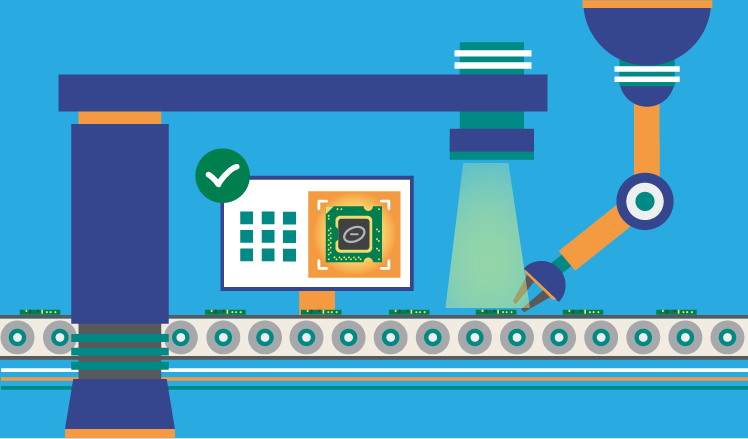A promising future of automated optical inspection in PCA quality control
According to the last market forecasts, a general growth of the surface technology segment together with an increase in the use of small-sized components will substantially drive the market for SMT inspection equipment and software. The current trend for miniaturization has resulted in shrinking of the smallest components of printed circuit assemblies (PCA) to about the size of a pencil point, which means that a higher accuracy is needed when placing active components onto the surface of the board. The same applies to the inspection of PCAs, which is becoming more and more challenging and requiring the most sophisticated software to assure the highest quality standards are met.
A research conducted at the University of Missouri suggested that manual inspection of PCBs hadn't been an option for more than 20 years already. Even as far back as in 1996, it was considered too slow and costly a technique, leading to excessive rejection rates and not assuring a reasonably high quality. Since then, components of printed circuit boards have become more and more precision-oriented and customized. This has led to a further decrease in the efficiency of manual inspection not only in terms of bare PCB inspection but also in PCB assemblies (PCA) quality check. In order to keep up with the times, more reliable and swift methods have been developed to ensure that product quality remains high.

Automated optical inspection takes up the challenge
Manufacturers today employ a range of advanced quality inspection techniques, including machine vision systems, such as automated optical inspection (AOI) and automated X-ray inspection (AXI) integrated into the SMT production line.
Acquiring and processing millions of pixels on a dime, machine vision systems can completely replace human visual inspection procedures in the future. They are able to conduct all the visual checks performed by people, but more rapidly and accurately. Armed with several light sources and high-resolution digital cameras, an AOI system can inspect the surface of a board detecting such problems as:
- surface feature defects (nodules, scratches, and stains);
- dimensional defects (open circuits, short circuits, insufficient or excessive soldering);
- defects of completeness (missing components, incorrect components, and misplaced components).
What is inside the box?
The most intriguing part of a machine vision system is the logic it applies to make the final decision on whether the assembly under inspection passes the test or not. Inspired by the human visual system, the machine vision algorithms first adjust the image quality to enhance contrast and diminish possible noise and then extract the most important features of the image to reduce amount of data to be processed (just like the eye, software empowered with the brain-like capacities adapts to excessive information flows of the visual world). For the last decades, researchers have proposed a number of techniques for image pre-processing in AOI of printed circuit assemblies, including the median filtering method, image subtraction operation, and wavelet thresholding algorithm.
The next step is the one where an AOI system processes the image of an electronic module, comparing it to the 'golden' reference samples (referential methods) or checking whether it conforms to the design specification rules (non-referential methods).
Major advances have been made in this area for the last years. Ever-growing computational capacities boosted the use of neural networks and fuzzy algorithms for industrial image analysis purposes. Several researchers have reported on the successful implementation of these algorithms for automated visual inspection of surface-mounted devices. At least one of these papers suggests the success rate of 93.93% when using neural networks to detect missing components in SMT assemblies. Multiple Neural Network Systems (MNNS) have shown much better results comparing to single networks comprising their layers, such as MLP and LVQ neural networks, while the time taken for image analysis was close to the lowest required by a single neural network. Another paper proposes a combination of histogram and template matching with a fuzzy logic system calculating the probability of a component being missed. This is a promising approach, although for now it can be used only as a support for more reliable inspection methods.
After analyzing the image of a printed circuit assembly, the AOI system proceeds to the decision step. This pass/fail stage is crucial not only for the future of the PCA under check, but also for the future of the machine vision system itself, as the percentage of right and wrong decisions affect the system credence. It is vital that errors of both types (false-positives and false-negatives) should be avoided equally, as a large percent of false alarms leads to the situation when the user starts ignoring alerts and the system becomes useless.
Most of the approaches discussed above agree at least on two points: referential techniques (such as template and pattern matching) and supervised neural network training methods (such as backpropagation) should be preferred over the alternatives.
Geometry strikes back
Despite the significant success of AOI systems in SMT manufacturing, there are still challenges to overcome. One of them is that some components and solder joints often are not fully accessible by simple 2D scanning, because they require inspection from different angles or because they are totally hidden. Different pad geometries also may affect image analysis results. So, when inspecting printed circuit boards mounted with three-dimensional components, it is small wonder that one plane might not be enough.
With the introduction of a rotating camera, it has become possible to implement different viewing directions to inspect the blind spots and dead angles. Besides that, 3D AOI has become increasingly popular to inspect component height, warpage, shift and lifted leads that are difficult to inspect via 2D AOI. An additional benefit can be derived from applying multiple illumination modalities to enhance the contrast of different parts.
The future of AOI
Since the complexity of PCAs, as well as the demand for their quality, increases AOI systems are developing rapidly, striving to fulfill ever-toughening requirements. Among the most important trends on which the experts agree is the further development of 3D AOI and multi-angled 2D views, combining AOI with X-ray inspection, improvement of measurement techniques used in AOI, and adaptive illumination. Advance in image analysis software, including neural networks, fuzzy logic systems, and other intelligent algorithms is expected to increase the efficiency and reliability of AOI systems dramatically.


